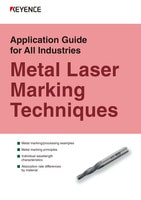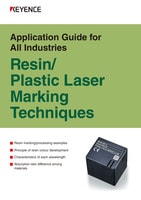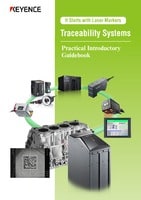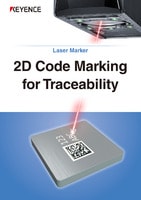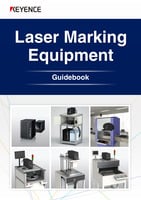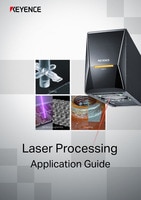Industrial Laser Marking Systems / Laser Markers
Laser Etching vs Laser Engraving vs Laser Marking: Which to Choose?
-
Tags:
- Laser Engraving , Laser Etching , Laser Marking
Laser etching and laser engraving are commonly thought of as interchangeable, but there is a difference between the two when it comes to their processes and results. Laser etching and laser engraving both have benefits and drawbacks depending on the project’s desired outcome.
The process of laser marking involves altering the appearance of a material's surface. Laser marking machine technology is ideal for bar codes, QR codes, data matrices, and logos, to name a few.
With that said, it is essential to understand the difference between laser etching vs laser marking vs laser engraving to ensure you choose the best option for your particular needs. In the following, we’ll take a look at each process, along with the top industries that utilise them.
Differences Between Laser Etching vs Laser Engraving vs Laser Marking
The full scope of this topic can get pretty convoluted, so it can help to compare each process side by side. In the table below, notice the several key differences between laser engraving, etching, and marking.
| Topic | Laser Etching | Laser Engraving | Laser Marking |
|---|---|---|---|
|
Applications
|
Laser Etching
Marks on polymers, metals, and ceramics.
|
Laser Engraving
Logos, serial numbers, and personalisation.
|
Laser Marking
Logos, barcodes, UID codes.
|
|
Alteration
|
Laser Etching
Methods of melting and material expansion.
|
Laser Engraving
Pulse vaporisation of material.
|
Laser Marking
Discolouration of material surface.
|
|
Core Process
|
Laser Etching
Melts surface material with heat.
|
Laser Engraving
Physically removes material from the surface of the item.
|
Laser Marking
Uses the beam to alter the surface with high contrast and low (to no) damage.
|
|
Strong suit
|
Laser Etching
Boosts visual contrast and reflectiveness.
|
Laser Engraving
Utilised for depth requirements or customising personal items.
|
Laser Marking
A go-to option for effective and efficient part and product identification.
|
There are many differences between these terms, each with a unique use case that continues to be used across many industries. However, it is understandable to compare laser etching vs engraving and marking and wonder why there’s a need for so many variations.
We’re here to provide you with more details.
Reach out today!

Laser Etching Process
Laser etching creates raised marks on metal material, such as aluminium, stainless steel, or zinc by electrolyte absorption. The laser etching process begins with a laser beam hitting and electrifying a metal, resulting in a current running through it. The metal then partially absorbs the energy and also reflects the energy.
Once the metal absorbs the energy and transforms it into heat, the metal becomes malleable, expands, and changes in colour and texture. The ratio of absorption to reflection affects whether the etch will be black, white, or grey. You may choose laser etching vs laser engraving vs laser marking for the stylistic reason of wanting raised marks instead of deep or even high contrast marks or because the process is generally faster.
Discover more about this product.
Click here to book your demo.

Laser Engraving Process vs the Laser Etching Process
Laser etching vs engraving are both techniques used to create designs, but they differ in how they interact with materials and the range of materials they can be applied to. Laser engraving involves vaporising the material, allowing for deep marks on metal, wood, or plastic.
On the other hand, laser etching makes the material malleable and causes expansion upon laser contact. When durability is a priority and the product must withstand environmental conditions, deep laser engraving is recommended to achieve deep, long-lasting marks. However, if the original material strength and rigidity must be preserved, laser etching becomes the preferred choice.
We’re here to provide you with more details.
Reach out today!

Laser Marking Process
Commonly referred to as discolouration, the laser marker process moves slowly across a surface for a high contrast result. One favourable characteristic of this process is that the marking can be applied with little to no damage, depending on the laser medium used.
The heat from the laser creates black marks through oxidation, or it can also apply less concentrated heat to anneal the surface. Regardless of the approach and the differences between laser marking and engraving, this process has helped manufacturers speed up operations.
Curious about our pricing?
Click here to find out more.

Laser Etching and Laser Engraving for Part Traceability
Although there is a difference between laser etching vs engraving, they both are essential for part traceability because of their permanence. Tracing parts, tools, or jigs through a plant or supply chain is necessary for an efficient recall, minimising damages, extracting and improving management challenges, and ensuring quality management.
There are two types of part traceability—chain traceability and internal traceability. Both of these use etching and engraving for success. Chain traceability traces a part’s progress from raw material to sale, whereas internal traceability tracks parts along the supply chain through a single company or plant.
For traceability, a tool, jig, or product is laser etched or laser engraved with a serial number that correlates with a description of the tool, such as usage, wear limits, plant names, shelf numbers, count, and date or time. Without traceability, a company may struggle with efficiency when attempting to recall or investigate an issue with a product.
Additionally, traceability allows consumers to feel confident in the reliability of their product because they know where their product came from. Although part traceability relates to tools, many industries use this practice for other products.
We’re here to provide you with more details.
Reach out today!

How Can Laser Markers Be Integrated?
A common gripe with conventional etching tools is the inefficiency of creating new designs. Since chemical etching tools may use a stencil, creating designs takes time, money, and additional materials. Instead of a physical stencil, laser markers simplify this process by reading and imitating programming based on data loaded from a CAD file.
Chemical etching is generally used for engraving or eliminating resin, but the process can be detrimental to the product because of its harsh nature. Laser markers are a great alternative since the laser produces the same result in a more efficient and consistent manner.
Sometimes, the deep cut of engraving is desired for a product, but roadblocks like difficulty engraving small characters and rough or curved surfaces can arise from using a conventional engraver. Additionally, conventional engraving machines can add stress to the material and be a tedious process, so using a laser marker rather than a hand-scribe or dot-peen is more efficient and gentle on materials.
Laser markers can also generate characters smaller than 1mm and mark on rough surfaces. Although some laser markers need external equipment to mark curved surfaces, certain Laser markers have this capability built-in. This flexibility is especially beneficial in the automotive industry. As an example, many parts have identification numbers laser marked in them, making part tracing simple and efficient.
Discover more about this product.
Click here to book your demo.

Why Do Manufacturers Need Laser Etching, Laser Engraving, and Laser Marking?
Considering laser marking vs laser engraving and etching from a global viewpoint, there are many apparent use cases across numerous industries.
Some of this comes down to regulation, while other angles focus on a necessary approach based on the type of materials that are involved. The list below provides a comprehensive look at why a laser marker for engraving, etching, and other applications is so vital.
- Regulation: Being able to resort to different benefits of laser marking can help manufacturers abide by a wide variety of product ID laws and regulations.
- Promised Durability: They are known to be highly resilient to external wear and easily outlast the capabilities of industrial inkjet printers.
- Efficiency: It continues to be proven that laser engraving applications and similar methods are much more efficient than traditional inkjet. The technology also helps mitigate human error and improve consistency from one item to the next.
- Eco-friendly: In our modern era, the manufacturing industry as a whole is in need of more eco-conscious solutions. This is another upside to laser technology over traditional options that can help reduce waste significantly.
Manufacturing technology is always evolving, and laser processes are becoming a prominent choice. The global manufacturing industry is recognising the benefits of lasers and how they help them stay competitive as these shifts occur. In short, manufacturers will continue to utilise laser etching, marking, and engraving to meet regulatory requirements, create durable and traceable marks, and improve efficiency.
We’re here to provide you with more details.
Reach out today!

What Industries Use Laser Etching and Engraving?
Etching and engraving are used in a variety of industries such as:
Although these are some of the most common industries, many others are utilising them and seeing the benefits that they offer. Both can be effectively used by anyone desiring permanently marked designs on a product, regardless of which industry they are in.
Curious about our pricing?
Click here to find out more.

Making the Decision
Deciding between laser etching vs laser engraving vs laser marking may seem challenging at first, but understanding your goals for a product, the material you’re working with, and the future use of a product can point to the best choice. Additionally, you may want to consider investing in a laser marker that can cut down overall cost, time, and the number of people needed for a project.
As a leading supplier of sensors, measuring systems, laser markers, microscopes, and machine vision systems worldwide, KEYENCE can help automate your processes, saving you both time and money.
Ready to implement etching or engraving but still have questions? Ask KEYENCE, and our knowledgeable team will get back to you quickly. We support our customers from the selection process to operations with on-site operating instructions and industry-leading after-sales support.
We’re here to provide you with more details.
Reach out today!


